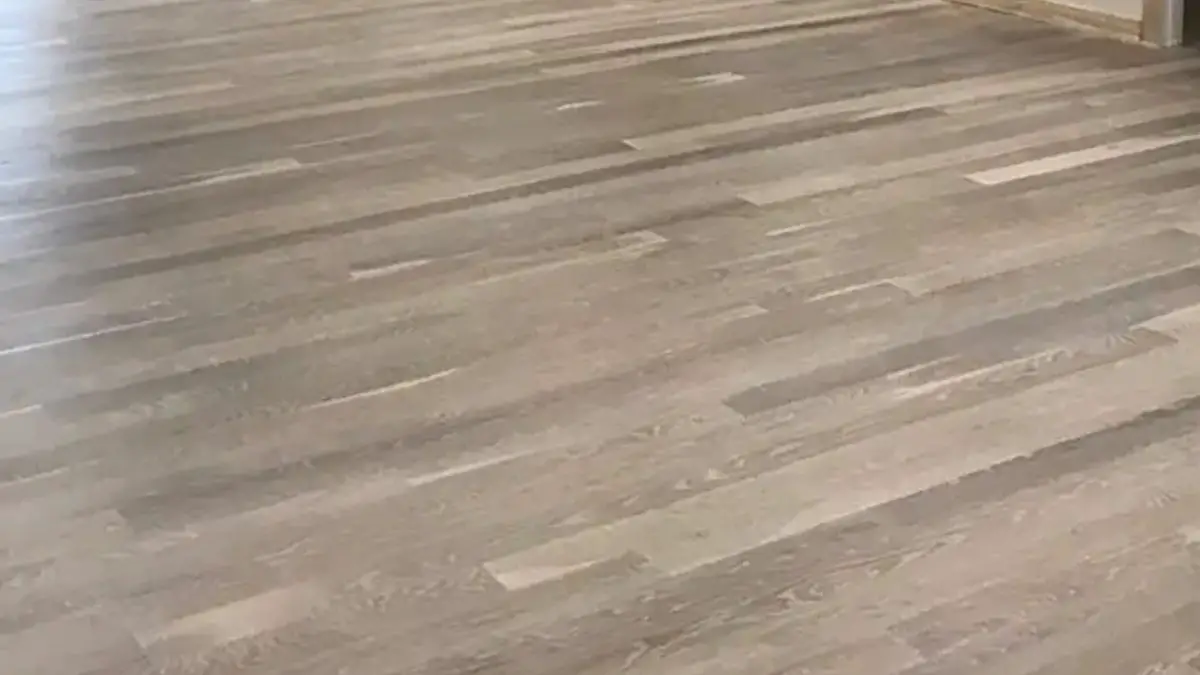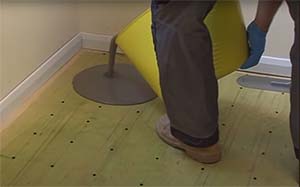
Concrete is trendy in many homes because it is incredibly versatile and robust. With that, most people use concrete for their subflooring, especially if you have a basement or want an even stronger foundation. But if you have ever worked in retail, you know that concrete is awful when you stand on it too long! It is hard and cold and will hurt your feet, leading to the question of if you can lay LVT, or luxury vinyl tile, on concrete floors.
The quick answer is that LVT (luxury vinyl tile) flooring can lay on the concrete, given that the installation process has been done accurately. Installed flooring on concrete means using the floating system or having it glued down with adhesive. Not only this, but if you are looking for an easy floor to install over concrete, vinyl flooring is the solution to this issue.
Bearing this in mind, there is much more to tell you that meets the eye, such as how to prepare your concrete, the proper installation process, how long does vinyl floors last on this type of subfloor, and one of the most frequently asked questions is if you need underlayment for LVT floors on concrete. Keep reading to find out more.
How Do You Prepare a Concrete Floor For LVT Flooring?
Before installing any flooring type, you must remember the subfloor’s preparation, whether it is concrete or plywood. Do not skip this step, as preparing beforehand is essential. Both subfloors typically both work the same ways, but since the two are different materials, there might be many differences between them. So let us go over how to prepare it before installing your luxury vinyl flooring properly.
- Take everything out of the area where you will install the floors.
- Repair any cracks or holes.
- Inspect the flooring for any cracks, holes, or uneven patches you may see.
- Use a concrete filler to repair the damage. However, if you see that the concrete has a large crack underneath, it is best to remove that area and replace it with a new slab.
- If you have to put brand new concrete on the floor, it cannot have anything flooring installed until 60 days after being replaced, so it is vital to wait until then.
- Grind any imperfections seem.
- Make sure the subfloor is as smooth as possible. If you see any parts on the ground with a glob, lump, or bulge of solid material on top of the initial floor itself, make sure you get rid of it.
- Use sandpaper or an electric sander of 40 or 60 grit, then take a damp rag and clear off the section.
- Wash the floors.
- On the last initial part, you will want to clean the floors entirely by first sweeping, then use water and any household detergent or degreaser to further get any dirt and grime off before leaving it to dry off completely.
- Perform a moisture test.
- Keeping the dampness level at its minimum is the best way to ensure your LVT floors will live to their full extent.
- With strong tape, put a sample piece of vinyl on your floor.
- Ensure all the sample edges are adequately sealed to keep air from leaving, then leave the tape on for 72 hours.
- After three days, pull the tape off the floor. If it comes off easily, this means the moisture levels are too high. If this is the case, use a dehumidifier for the room.
- In this final step, apply either the underlayment or LVT flooring.
- Although deemed unnecessary, it is good to have an extra barrier of protection underneath your floors. We will go over this more in-depth in a bit.
How Do You Install LVT Flooring On Concrete?
Congratulations, you have finally made it to the installation process of putting your luxury vinyl tile down after so much prep work! As I am sure you know by now, LVT floors are one of the easiest floorings to install, especially over concrete floors. Many homeowners get them for this very reason. That said, let’s get to the nitty-gritty detail on how to install LVT on concrete properly, shall we?
- Prepare the subfloor, as we went over step-by-step above.
- Provide extra insulation: this means underlayment if you so desired. As I mentioned, we will look over this in a while.
- Remove all baseboards before installing: Make sure to leave 1/4th an inch between the LVT floors and wall for expansion and condensing. In doing so, it will also help with preventing buckling in the future.
- Lastly, read the instruction manual on how to install floating and glued down LVT flooring.
See our article Best Flooring Types for Concrete Slab: Pros/Cons & Costs for more flooring options suitable for concrete slab.
Do I Need Underlayment For LVT Flooring On Concrete?
When you think about concrete, what is the first thing that comes to mind? For some people, it is the fact that although, yes, concrete is durable, the material in itself is very cool. One might be wondering if you can put underlayment between the concrete and your LVT flooring.
Since the vinyl in itself comes with a pad, it is not necessary. However, if your floors tend to get damp underneath, or if you want to protect the floors better from an uneven surface, an underlay is a way to go.
There are a couple we recommend due to how well they hold up. Every underlayment has been categorized into three different parts: STC (Sound Transmission Class), ICC (Impact Isolation Class), and R-Value (thermal resistance).
The higher the number is, the better sound (STC), insulation (ICC), and heat resistance (R-Value) each padding has.
MP Global Products QuietWalk
Being one of the best and affordable options out there, Global Products is one of the top qualities for vinyl floors. It provides extra cushion, sound dampening qualities, durability, giving warmth, sturdiness, and moisture barrier. On top of that, this underlayment is recyclable, which makes it all the more worth getting. This underlay can be used for both floors used with adhesive and floating LVT floors.
- STC: 66
- IIC: 71
- R-Value: .58
- Thickness: 3.2mm
Silent Vapor Barrier Underlayment
Silent Vapor Barrier is an excellent choice for your LVT flooring due to how easy it is to install and appropriate for any subfloor, including concrete. Silent Vapor is for floating vinyl, so if you wish to use adhesive, make sure you check the instructions to make sure it is okay to do so. On top of these features, Silent Vapor is recyclable, exceeds VOC requirements, and has antimicrobial treatment.
- STC Rating: 65
- IIC Rating: 70
- R-Value: .15
- Thickness: 1 mm
How Long Will LVT Last On Concrete?
On average, luxury vinyl tile has a lifespan between 10 to 20 years but is known to last up to 50 years.
Routine floor care is essential for a better lifespan of the floors by regularly sweeping and mopping, having light traffic if possible, using furniture pads, and keeping hard or sharp objects off the ground.
You can also protect your floor from UV rays by placing large furniture or rugs with natural backings (cotton, jute, or woven.)
The Best Thickness Of LVT For Concrete Floors
Vinyl planks come in thickness anywhere between 2mm to 8mm. As a general rule, the thicker your LVT floors are, the better, but if your concrete floors are even, you can go with a thinner vinyl flooring because your floors are sturdy enough not to need the extra support. The thickness provides more comfort and stability underneath.
Although many vinyl flooring comes in all different shapes and sizes, it is essential to pay attention to your wear layer’s thickness, a protective coating over the vinyl print. If the wear layer gets ruined, then this means your LVT floors’ pattern will get run down as well, and we would not want that.
That being said, the recommendation for homeowners is to have a wear layer thickness of 12 mil, 20 mil for residents with animals and children, and a minimum of 28 mil for commercial properties.
Is LVT Waterproof?
You might be wondering if you can put your luxury vinyl tiles in the bathroom or kitchen, where the house has the most moisture and creates many spills.
An excellent example of this is a dog who is a messy drinker or has younger children who are just now learning how to use a regular cup properly. LVT floors are indeed waterproof and can withstand heavy foot traffic, making them an excellent choice to pick for within your home.
That being said, because concrete is not fully waterproof, adding these floors and underlayment will guarantee that the subfloor will last a reasonably long time. As mentioned previously, make sure you check the moisture levels before installing any flooring.
Does LVT Need To Be Glued On Or Laid Loose On Concrete?
Vinyl floors can be laid loose or glued down, depending on what you decide to do. Floating floors use little to no glue, whereas click-vinyl flooring can be snapped together in place, which does not require glue. When using underlayment, make sure you check the manual beforehand to see if you can use adhesive. If you are still uncertain, ask your flooring instructor to help you out.
There are two ways you can glue with, which are both suitable for LVT floors:
- Hard set gluing fixture: Recommended for high-traffic areas, like in commercial buildings, wheeled equipment, and if the floors get higher traffic. Hard set glue holds the planks firmly into place. Something to note is that it will be harder to replace tiles if an accident were to occur.
- Pressure-sensitive gluing fixture: This adhesive makes the floors sturdy, and your LVT flooring will be much easier to remove, especially with a specific area that is damaged. It benefits greatly when the floors are uneven.
Conclusion
All in all, LVT flooring can be laid on concrete. All we have to do is make sure the surface itself has been thoroughly cleaned from any dirt, grime, cracks, or uneven surfaces. If you follow the protocols above, it should not be an issue. However, asking for professional help is always an excellent option to ensure the surface’s proper laying.







